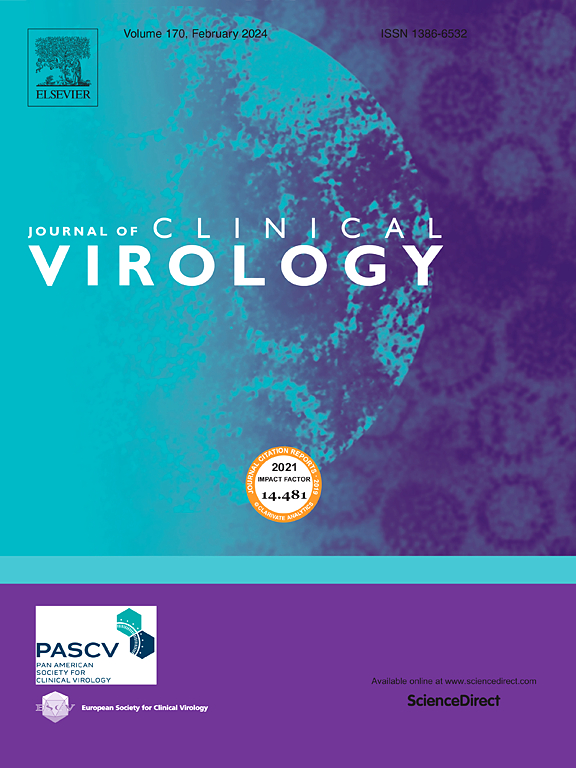Cytomegalovirus urinary excretion in children with congenital and postnatally acquired infection
IF 3.4
3区 医学
Q2 VIROLOGY
引用次数: 0
Abstract
Background
Cytomegalovirus (CMV) infection in children is associated with prolonged viral excretion in urine and saliva. This study characterizes CMV urinary excretion in children with congenital (cCMV) and postnatally acquired CMV infection.
Methods
Children with virologically confirmed cCMV (75 symptomatic and 105 asymptomatic at birth) and 51 children without cCMV were followed through median 11, 18 and 17 years of age, respectively. In children with cCMV, duration of CMV excretion was defined as uninterrupted positive results from initial to last positive culture, and recurrent CMV excretion as ≥1 positive following >1 negative result. CMV urinary excretion in children without cCMV was defined as resulting from postnatally acquired CMV infection.
Results
Mean duration of persistent CMV urinary excretion in children with cCMV was 1.9 (maximum 8.7) years for symptomatic and 2.8 (maximum 9.8) years for asymptomatic children (P = 0.011). Mean duration of CMV excretion was not statistically different for 17 symptomatic children treated with ganciclovir (2.4 years) compared with 58 untreated (1.8 years); P = 0.356. Recurrent excretion occurred in 19 (25 %) symptomatic and 21 (20 %) asymptomatic children, at mean age 4.0 and 6.2 years, respectively (P = 0.084). In 16 (31 %) children with postnatally acquired CMV infection, CMV urinary excretion began at mean age 1.8 (range 0.3–7.3) years.
Conclusions
Both symptomatic and asymptomatic cCMV were associated with persistent long-term CMV excretion in urine, which was significantly longer in asymptomatic cCMV and not influenced by ganciclovir treatment in symptomatic cCMV. CMV urinary excretion was common in young children without cCMV, suggesting rapid CMV acquisition in childhood.
巨细胞病毒尿排泄与先天性和后天获得性感染的儿童。
背景:儿童巨细胞病毒(CMV)感染与尿和唾液中病毒排泄时间延长有关。本研究探讨先天性(cCMV)和出生后获得性巨细胞病毒感染儿童巨细胞病毒尿排泄的特点。方法:对病毒学确诊的cCMV患儿(75例出生时有症状,105例出生时无症状)和51例无cCMV患儿进行随访,中位年龄分别为11岁、18岁和17岁。在cCMV患儿中,CMV排泄持续时间定义为从最初到最后一次阳性培养不间断的阳性结果,在>1阴性结果后CMV排泄复发≥1阳性。没有cmmv的儿童的巨细胞病毒尿排泄被定义为出生后获得性巨细胞病毒感染。结果:cCMV患儿持续CMV尿排泄的平均持续时间,有症状者为1.9年(最长8.7年),无症状者为2.8年(最长9.8年)(P = 0.011)。接受更昔洛韦治疗的17名有症状儿童(2.4年)与未接受治疗的58名(1.8年)相比,CMV排泄的平均持续时间无统计学差异;P = 0.356。有症状和无症状儿童分别有19例(25%)和21例(20%)出现反复排泄,平均年龄分别为4.0岁和6.2岁(P = 0.084)。在16例(31%)出生后获得性巨细胞病毒感染的儿童中,巨细胞病毒尿排泄开始于平均年龄1.8岁(范围0.3-7.3岁)。结论:有症状和无症状的cCMV都与CMV在尿液中持续的长期排泄有关,无症状的cCMV明显更长,更昔洛韦治疗对有症状的cCMV没有影响。巨细胞病毒尿排泄在没有cCMV的幼儿中很常见,提示儿童期巨细胞病毒获得迅速。
本文章由计算机程序翻译,如有差异,请以英文原文为准。
求助全文
约1分钟内获得全文
求助全文
来源期刊

Journal of Clinical Virology
医学-病毒学
CiteScore
22.70
自引率
1.10%
发文量
149
审稿时长
24 days
期刊介绍:
The Journal of Clinical Virology, an esteemed international publication, serves as the official journal for both the Pan American Society for Clinical Virology and The European Society for Clinical Virology. Dedicated to advancing the understanding of human virology in clinical settings, the Journal of Clinical Virology focuses on disseminating research papers and reviews pertaining to the clinical aspects of virology. Its scope encompasses articles discussing diagnostic methodologies and virus-induced clinical conditions, with an emphasis on practicality and relevance to clinical practice.
The journal publishes on topics that include:
• new diagnostic technologies
• nucleic acid amplification and serologic testing
• targeted and metagenomic next-generation sequencing
• emerging pandemic viral threats
• respiratory viruses
• transplant viruses
• chronic viral infections
• cancer-associated viruses
• gastrointestinal viruses
• central nervous system viruses
• one health (excludes animal health)
 求助内容:
求助内容: 应助结果提醒方式:
应助结果提醒方式:


